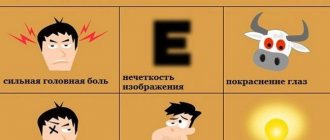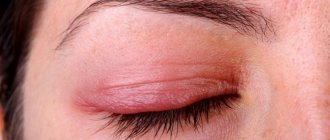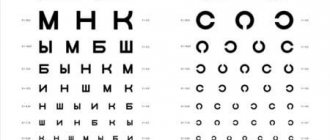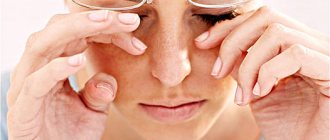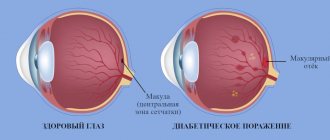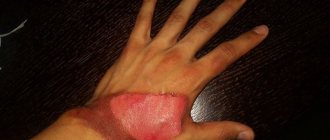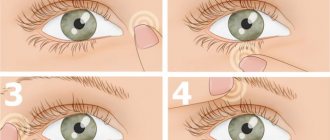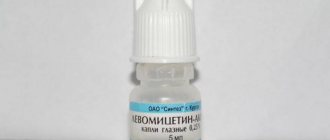A nervous tic is a sudden, repetitive movement that occurs as a result of involuntary contraction of a specific muscle group. For example, it is often said that “the eye twitches.” Twitching can affect different muscles, spread from one muscle group to another, and even cover almost the entire body.
Movements during tics are obsessive and a person cannot control them. When you try to suppress a tic, the tension increases and as a result the tic only gets worse.
The most common tic occurs in childhood, and it is detected somewhat more often in boys than in girls. It is believed that tics occur in 13% of boys and 11% of girls.
Causes of nervous tics
The causes of tics are usually grouped as follows:
- primary tics
caused by psychogenic factors. In this case, there are no organic pathologies. The occurrence of a tic can be caused by stress, fear, depression, and neurosis. It is this type of tics that most often occurs in children. The cause of a nervous tic in a child can be psycho-emotional trauma, increased anxiety, obsessive fear, attention deficit hyperactivity disorder (ADHD); - secondary tics
. In this case, the tic is a consequence of any diseases that cause disruption of brain activity. These may be infectious diseases (encephalitis), intoxication, brain injury, cerebrovascular accidents; - hereditary tics.
Risk factors and causes
The areas of the brain responsible for ocular tics remain unclear; most forms are caused by basal ganglia dysfunction, but increasing evidence suggests that a network of additional cortical and subcortical structures may be involved. Imaging studies of idiopathic blepharospasm have shown abnormal activity in several areas. For example, magnetic resonance imaging and positron emission tomography indicate such activity in the somatosensory and cingulate cortex, thalamus, caudate nucleus, cerebellum, and brain stem. At the same time, it is difficult to distinguish which changes reflect the causative agent for blepharospasm, and which affect the consequences.
Risk factors for the development of blepharospasm:
- dry eyes (a common problem for people who spend a lot of time at the computer or wear contact lenses);
- eye fatigue;
- eye problems (photosensitivity, blepharitis, conjunctivitis);
- stressful conditions, nervousness;
- excessive caffeine consumption;
- alcohol addiction;
- nutritional imbalances and deficiencies of certain nutrients (particularly magnesium);
- excessive physical activity;
- allergic reactions (histamine is released in the tissues of the eyelids and tear fluid when the eyes are rubbed, and according to some studies, this can cause eyelid tic);
- Meige's syndrome (usually involves blepharospasm as part of uncontrolled facial movements);
- side effects from certain drugs (long-term use of benzodiazepines is a known risk factor for the development of blepharospasm). Medicines that are used to treat Parkinson's disease also include estrogen replacement therapy for women going through menopause.
Sometimes there is apraxia of eyelid opening, which complicates the diagnosis and treatment of eye tics. Blepharospasm can be caused by concussions (in some rare cases, when a blow to the back of the head damages the basal ganglia).
Symptoms of a nervous tic
Involuntary movements can affect only one muscle group - such tics are called local
.
There are also simple and complex tics. A simple tic is a complex of the simplest movements of the same type. With a complex tic, involuntary movements affect several muscle groups. A severe type of the disease is a generalized tic
, affecting almost the entire body. With this type of tic, involuntary movements usually begin in the face, then involve the muscles of the neck, shoulders, arms, chest, abdomen and back, and even legs.
Most often, tics affect the facial muscles. In this case, such movements as blinking, moving the lips, opening the mouth, moving the eyebrows, and twitching the nose are characteristic. When a tic spreads to the neck and shoulders, nodding and shaking of the head are typical. Tic spreading to the limbs is expressed in the form of flapping of arms, clapping of palms, stamping and jumping.
A group of vocal manifestations is also distinguished. In this case, screams, coughing, howling, uttering curses, and incoherent speech may be observed.
Treatment
Finding an effective treatment regimen often involves trial and error for each eye tic patient. Treatment with anticholinergics, tranquilizers, and botulinum toxin are the main options. But they are associated with a number of side effects, so it is not surprising that new methods are constantly tested and assessed for safety. Against this background, mosapride is an available option.
- Botulinum neurotoxin injections (examples: Botox and Dysport) work by inhibiting the release of acetylcholine at the neuromuscular junction, which reduces twitching and helps normalize muscle activity. The effects of Botox are temporary and reversible; the injections are typically given every three months and usually provide quick relief from muscle spasms.
- Anticholinergic drugs (trihexyphenidyl, benztropine, biperiden, atropine, procyclidine, diphenhydramine, scopolamine, ethopropazine) have limited benefit due to side effects. It is important to start treatment at the lowest possible dose and slowly escalate it over several weeks or even several months. The most common adverse effects in adults associated with anticholinergic agents include blurred vision, dry mouth, confusion, sedation and memory problems, and additional urinary retention.
- Dopaminergic drugs are used in the treatment of Parkinson's disease and, although dystonia is clearly different, carbidopa/levodopa and other dopamine agonists are sometimes administered to patients with focal dystonia, including blepharospasm.
Surgery is warranted if drug therapy or injections are ineffective for tics, especially when there is a risk of serious side effects.
Blepharospasms in children
In general, when the eye twitches, the causes and treatment in adults are standard. It's more difficult with children. Rapid blinking and eye rolling are common reasons for referral to pediatric ophthalmology and neurologists, but there is little convincing information regarding the natural history of ocular tics without underlying medical conditions (eg, Tourette's syndrome).
Many parents believe that a child's twitching eye is an irritating factor that interferes with learning and other daily activities, and can socially isolate and cause physical discomfort. But it's important to focus on the problem, not the treatment. Children face a lot of stress on their visual system. Tics may subside, and sometimes the right thing to do is simply wait for time to pass and calm the child down rather than treat him with medication.
When prescribing medications, dose titration is used:
- Alpha2-adrenergic agonists are moderately effective for tics. The most commonly used drug in the past was clonidine. Guanfacine is now preferred because it is less sedating and is taken once at bedtime or twice (morning and evening), compared with the three to four doses required for clonidine.
- Drugs that block dopamine receptors are prescribed if alpha2-adrenergic agonists do not provide benefit. These are powerful and predictably effective eye tic suppressants. Although haloperidol, pimozide, and fluphenazine have been shown to be effective in controlled clinical trials, they have fallen out of favor due to frequent side effects, especially sedation, depression, and mental dulling. Children are prescribed atypical antipsychotics (risperidone and aripiprazole), but they are often poorly tolerated and are associated with weight gain and the development of metabolic syndrome.
- In cases where alpha2-agonists and antipsychotics have inadequate response or tolerability problems, focus on other types of medications. Clonazepam and tetrabenazine have a moderate degree of tic suppression.
Cognitive behavioral therapy
Medicines, as a rule, cannot cure nervous tics. At best, pharmacotherapy provides only temporary relief. Because the disease is neurological in nature, doctors are exploring sensorimotor correction so that the brain can repurpose itself and eliminate the dystonic movements.
Correct and dysfunctional coordination coexist simultaneously. This suggests that the body is naturally able to restore proper coordination without drugs. The goal of behavioral therapy is to facilitate a reorganization process known as neuroplasticity. A person learns to avoid self-destructive actions, control his thoughts, behavior, use his imagination and pay attention to the subtle relationships between emotions and movements.
Sensorimotor correction and proprioceptive stimulation allows you to restore function lost due to blepharospasm. The works of Georgy Nikolaevich Sytin are devoted to the neuroplasticity of the brain.
Your doctor may also prescribe antidepressants, but not for tics. They are useful if you have depression that makes your symptoms worse. The drugs have a calming effect, reduce symptoms of anxiety, sadness, and obsessive-compulsive disorder.
Milgamma may be suggested. Known as a natural elixir, it contains B complex vitamins and lidocaine to help stimulate nerve tissue regeneration. The fact that it contains 100 mg of B6 excludes the use of the drug during pregnancy and lactation (excessive amounts of B6 can cause high blood pressure, sleep problems, and rapid heartbeat).
Homeopathic treatment
The goal of homeopathy for any disease is to find a remedy that suits the physical and emotional health of the patient. It is prescribed based on individual symptoms, feelings, mood for treatment, and resonates with the energetic vibrations of the problem. The huge list of homeopathic medicines for the treatment of eye tics includes:
- Agaricus muscarius.
- Cuprum metallicum.
- Argentum nitricum.
Any homeopathic remedy is only a recommendation. Before treatment with it, other factors must be considered, therefore, take the drug only after consultation with a homeopathic doctor.
Alternative treatments for blepharospasm include herbal remedies, hypnosis and acupuncture.
When should you see a doctor if you have a tic?
Every person can experience involuntary muscle contractions under great emotional stress (for example, eyelid twitching). If such manifestations are observed within 2 weeks (including repeated single tics), then this is already a disease. Tics that last less than a year are called transient (temporary). If a tic persists for more than a year, it is called chronic. Simple transient tics usually go away on their own. However, it is still necessary to see a doctor to reduce the risk of the tic becoming stronger and stronger.
Symptoms
The main manifestation of a tic is a sudden, periodic contraction of the external eye muscle. The contraction is involuntary, practically uncontrollable, i.e. it cannot be suppressed by force of will. The degree of contraction can vary: from a slight twitch of the eyelids, barely noticeable to those around, to complete closure of the palpebral fissure. The amplitude of the nervous tic of the eye is also individual.
Blepharospasm usually occurs during or immediately after emotional stress and stops as soon as the person calms down. The more “fixation” occurs on the very sensation of twitching, the more a person tries to influence the muscle spasm through willpower, the more painful (in moral terms) the nervous tic of the eye is usually tolerated. Muscle contraction itself does not cause pain. Tics do not occur during sleep.
For some people, a nervous tic of the eye becomes the reason for withdrawing into oneself: a visual defect attracts the attention of strangers on the street and in transport, causing a lot of inconvenience. This leads to worsening neuroticism, which, in turn, can intensify the manifestations of blepharospasm.
Treatment of nervous tics
Nervous tics are treated by a neurologist. In case of primary tic, a psychotherapist can help. Primary tics in children usually go away with age. To relieve symptoms and speed up recovery, it is recommended:
- normalization and adherence to the daily routine. It is necessary to get up, eat and go to bed at approximately the same time;
- proper and balanced nutrition;
- active lifestyle, sports, walks in the fresh air;
- eliminating excessive mental stress;
- reduction of psycho-emotional stress. Normalization of relationships in the family, and for the child also at school, is of great importance.
If tic manifestations are severe, the doctor may prescribe medication. For secondary tics, treatment is primarily aimed at combating the underlying disease that caused the tic. In most cases, with successful treatment of the underlying disease, the tic disappears.
Massage and reflexology are also used to treat tics.
What is blepharospasm
A form of focal dystonia representing the involuntary closure of the eyelids due to overactivity of the muscles around the eyes, especially the orbicularis muscle, blepharospasm is classified into idiopathic (essential) and reflex, depending on whether a cause can be identified. The primary/idiopathic type is described as benign to distinguish it from secondary/reflex blepharospasm, which is associated with brain damage or exposure to certain drugs, or it accompanies neurological diseases such as Parkinson's disease. In other words, we are talking about a nervous tic, the causes and treatment of which depend on the underlying disease.
Benign indicates a condition that is not life-threatening, idiopathic indicates an unknown etiology. These include both cranial and focal dystonia (abnormal involuntary prolonged muscle contractions and spasms). Patients with blepharospasm have normal vision.
The most common form usually affects only the lower eyelid and is temporary in nature, but is irritating and can sometimes last for quite a long time. A number of pathologies associated with the problem of blinking require specialist evaluation.
Usually the eye begins to twitch gradually. In the early stages, this occurs only under certain stress factors (bright light, fatigue, emotional stress). Over time, the condition progresses and the eye continues to pulsate continuously throughout the day. Some people find that symptoms go away during sleep or that the blinking can be stopped by concentrating on certain tasks.
In extreme cases, tics cause light sensitivity or blurred vision, forcing the eyelids to remain closed for several hours and leaving the person functionally blind.
How is neuralgia treated with Botox in Kyiv?
Before Botox treatment, you should avoid drinking alcohol at least one day before the date of surgery, as well as taking aspirin. You should not engage in physical activity. The botulinum toxin injection procedure does not take much time. First, the doctor numbs the injection site with a special cream. Then the drug is injected with a thin needle two millimeters deep into the skin. The number of injections depends on the affected area, the distance between them is no more than two centimeters.
The procedure lasts on average about half an hour. In this case, from 40 to 300 units of botulinum toxin are injected into the body. The effect is achieved in a couple of days, the maximum – in two weeks. The duration of action of the drug is from four to six months.
As a result of Botox injection in a patient:
- uncontrolled muscle movements stop;
- acute pain goes away;
- motor ability increases.
